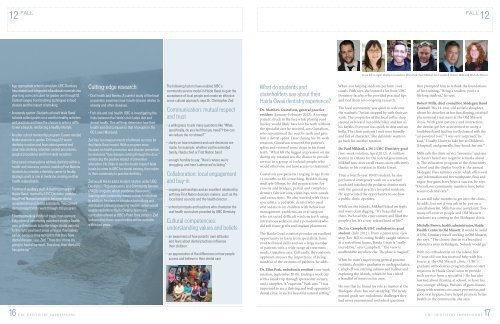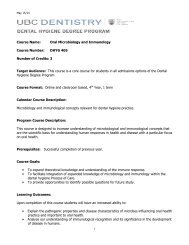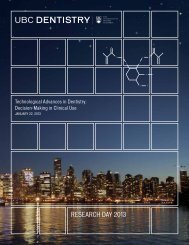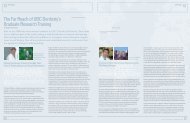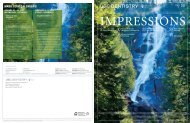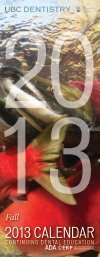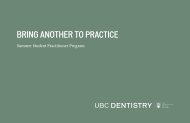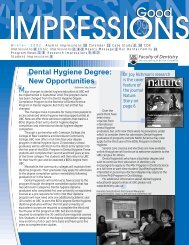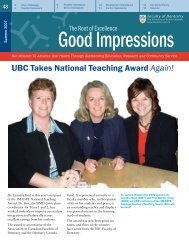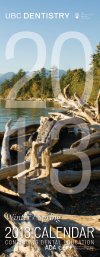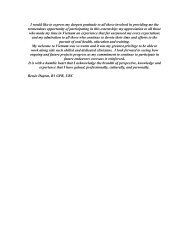Download a PDF of the fall 2012 edition - UBC Dentistry - University ...
Download a PDF of the fall 2012 edition - UBC Dentistry - University ...
Download a PDF of the fall 2012 edition - UBC Dentistry - University ...
- No tags were found...
Create successful ePaper yourself
Turn your PDF publications into a flip-book with our unique Google optimized e-Paper software.
12 FALLFALL12From left to right: Mat<strong>the</strong>w Gustafson, Ellen Park, Paul Mikhail, Les Campbell, Robert Mills and Michelle Brown.· Age-appropriate school curriculum: <strong>UBC</strong> <strong>Dentistry</strong>has created and integrated educational materials intoyear-long core curriculum for grades one through 12.Content ranges from brushing techniques to foodchoices and <strong>the</strong> impact <strong>of</strong> smoking.· A rewards system: Students at local Haida Gwaiischools collect points on a card for healthy activitiesand practices and have <strong>the</strong> chance to enter a raffleto win a bicycle, reinforcing a healthy lifestyle.· An after-school mentorship program: Career-mindedHaida students in grades 10 through 12 watchdentistry in action and learn about general andchair-side dentistry, infection control procedures,surgical procedures and front-desk reception.Structured conversations address dentistry within ahealth-and-sciences context, enabling First Nationsstudents to consider a dentistry career (a facultystrategic goal) or one in medicine, nursing or o<strong>the</strong>rhealth-related fields.· Training <strong>of</strong> auxiliary staff: A training program inHaida Gwaii, started by <strong>UBC</strong> <strong>Dentistry</strong>, enableslocal First Nations people to become dentalreceptionists and dental assistants. Two currentdental receptionists went through this program.· Effective medical model <strong>of</strong> triage management:Education <strong>of</strong> community members enables healthcare pr<strong>of</strong>essionals to better triage dental patientsto <strong>the</strong> right treatment areas or triage <strong>the</strong>mselvesearlier, because <strong>the</strong>y recognize that <strong>the</strong>y havedental disease, says Zed. “They don’t think it’sgoing to heal all by itself. Therefore, <strong>the</strong>ir dental IQhas gone up.”Cutting-edge research· Oral health and fitness: A current study <strong>of</strong> <strong>the</strong> localpopulation examines how mouth disease relates toobesity and o<strong>the</strong>r diseases.· Fish oils and oral health: <strong>UBC</strong> is investigating <strong>the</strong>links between <strong>the</strong> Haida’s fish-laden diet anddental health. This will help determine how <strong>the</strong>irhealth and diet compare to that <strong>of</strong> people in <strong>the</strong>BC Lower Mainland.Zed has two measurements <strong>of</strong> ultimate success for<strong>the</strong> Haida Gwaii model. With a program morefocused on health promotion and disease prevention,he envisions “less disease coming through <strong>the</strong> door,”reinforcing <strong>the</strong> positive impact <strong>of</strong> preventiveeducation. He’d like to see <strong>the</strong> model inspire Haidalocals to come to <strong>UBC</strong> for dental training, <strong>the</strong>n returnto <strong>the</strong>ir community to practise dentistry.Zed would like to add a student rotation under <strong>UBC</strong><strong>Dentistry</strong>’s Pr<strong>of</strong>essionalism and Community Service(PACS) program, which combines classroomlearning with community-based outreach initiatives.In addition, he plans to introduce technology anddistributive (distance) learning models, which wouldenable students in Haida Gwaii to learn corecurriculum <strong>of</strong>fered at <strong>UBC</strong>’s Point Grey campus. Zedbelieves that <strong>the</strong>se opportunities will be availablewithin two years.The following factors have enabled <strong>UBC</strong>’scommunity service model in Haida Gwaii to gain <strong>the</strong>acceptance <strong>of</strong> local people and create an effectivecross-cultural approach, says Dr. Christopher Zed:Communication: mutual respectand trust· a willingness to ask many questions like “What,specifically, do you feel that you need? How canwe reduce <strong>the</strong> no-shows?”· clarity on how treatment and care decisions aremade; for example, whe<strong>the</strong>r via <strong>the</strong> extendedfamily, Haida chief or First Nation band· enough humility to say: “Here’s where we’restruggling, and here’s where we’re failing”Collaboration: local engagementand buy-in· ongoing partnerships and an excellent relationshipwith key First Nation decision-makers, such as <strong>the</strong>local band councils and <strong>the</strong> health director· school principals and teachers who champion <strong>the</strong>oral health curriculum provided by <strong>UBC</strong> <strong>Dentistry</strong>Cultural competencies:understanding values and beliefs· an awareness <strong>of</strong> how parents’ own attitudesand fears about dental practices influence<strong>the</strong>ir children· an appreciation <strong>of</strong> <strong>the</strong> differences in how peopleaccess and believe in <strong>the</strong>ir dental careWhat do students andstakeholders say about <strong>the</strong>irHaida Gwaii dentistry experience?Dr. Mat<strong>the</strong>w Gustafson, general practiceresident (January-February <strong>2012</strong>): A teenagepatient struck in <strong>the</strong> face while playing roadhockey would likely have lost his teeth without<strong>the</strong> specialist care he received, says Gustafson,who repositioned <strong>the</strong> youth’s teeth and gavehim a dental splint. Later during his 10-weekrotation, Gustafson removed <strong>the</strong> patient’ssplint and restored some chips in his frontteeth. “What left <strong>the</strong> biggest impression on meduring my rotation was <strong>the</strong> chance to provideservice to a group <strong>of</strong> isolated people whowould o<strong>the</strong>rwise not have access to treatment.”Gustafson saw patients ranging in age from11 months to 80-something. Besides doingmultiple fillings, he did preparations forcrowns and bridges, partial and completedenture fabrications, cleanings, root canalsand extractions. He also worked with threespecialists: a pediatric dentist who usedoral sedation on children with behaviourmanagement problems, an oral surgeonwho extracted difficult wisdom teeth usingintravenous sedation, and a periodontist whodid s<strong>of</strong>t tissue grafts and implant placement.The Haida Gwaii rotation provides an excellentopportunity to learn from specialists, honeyour technical skills and see a large number<strong>of</strong> patients with a wide range <strong>of</strong> treatmentneeds, Gustafson says. Culturally, <strong>the</strong> rotation’sapproach stresses <strong>the</strong> importance <strong>of</strong> beingmindful <strong>of</strong> <strong>the</strong> customs <strong>of</strong> patients, he adds.Dr. Ellen Park, endodontic resident (one-weekrotation, September 2010): Ending a work daywith a kayak trip through spectacular scenery,and a campfire, is “exquisite,” Park says. “I wasimpressed to see a thriving and well-appointeddental clinic in such a beautiful natural setting.”When not helping students perform rootcanals, Park says, she learned a lot from <strong>UBC</strong><strong>Dentistry</strong> faculty, who provided practical tipsand tied <strong>the</strong>m into ongoing research.The local community was quick to welcome<strong>the</strong> students: “Artists stopped by with <strong>the</strong>ir artwork. The proprietor <strong>of</strong> <strong>the</strong> local c<strong>of</strong>fee shopsteered us toward incredible hikes and lent ushis kayaks. Everyone was quick to chat and sayhello. The clinic patients I met were friendlyand full <strong>of</strong> character.” She definitely wants togo back for ano<strong>the</strong>r rotation.Dr. Paul Mikhail, a <strong>2012</strong> <strong>UBC</strong> <strong>Dentistry</strong> grad(two-week rotation, April <strong>2012</strong>): A militarydentist in Ottawa for <strong>the</strong> federal government,Mikhail now does recall exams more efficientlythanks to his rotation in Haida Gwaii.Then a fourth-year DMD student, he alsoperformed emergency work on a crackedtooth and watched <strong>the</strong> pediatric dentist workwith <strong>the</strong> general practice hospital residents.He appreciated <strong>the</strong> opportunity to see howa public clinic operates.While on <strong>the</strong> islands, Mikhail hiked on trailsand went clam digging. “It’s beautiful out<strong>the</strong>re. We loved <strong>the</strong> environment and liked <strong>the</strong>people a lot. It’s a very relaxed kind <strong>of</strong> life.”Dr. Les Campbell, <strong>UBC</strong> endodontics gradstudent (July <strong>2012</strong>): From a panoramic viewatop Tow Hill to eating freshly caught salmonat a waterfront home, Haida Gwaii is “reallyincredible,” says Campbell. “The view isunaffordable anywhere else. The place is magical.”When he wasn’t supervising general practiceresidents, dentistry graduates or undergraduates,Campbell was catching salmon and halibut andexploring <strong>the</strong> islands, which he has visiteda handful <strong>of</strong> times on his own.He says that he found his role as mentor at <strong>the</strong>Skidegate clinic fun and satisfying. The newlyminted grads saw endodontic challenges <strong>the</strong>yhad never encountered and asked questionsthat prompted him to rethink <strong>the</strong> foundations<strong>of</strong> his training. “Being a teacher, you’re alifelong student,” he says.Robert Mills, chief councillor, Skidegate BandCouncil: His 14-year-old autistic daughter,whom he describes as low functioning, receivedphenomenal treatment at <strong>the</strong> Old Massettclinic. With great patience and interaction,<strong>the</strong> dentist got her accustomed to using atoothbrush and had her teeth cleaned with <strong>the</strong>“air-powered tool.” “I was very surprised,” hesaid. “Usually, I have to take her to Children’s[Hospital] and generally, <strong>the</strong>y knock her out.”Mills calls <strong>the</strong> clinic service “awesome” and sayshe hasn’t heard any negative remarks aboutit. The education program at <strong>the</strong> elementaryschool and <strong>the</strong> display booth at <strong>the</strong> annualSkidegate Days summer event, which <strong>of</strong>fers oralcare information and free toothpaste, floss andsugar-free gum, have been a success, he says.“Overall, our community members have betteraccess to dental care.”It can still take months to get into <strong>the</strong> clinic,he adds, but not if you ask to be put on acancellation list. Mills has one complaint: Toomany <strong>of</strong>f-reserve people and Old Massettresidents are coming to <strong>the</strong> Skidegate clinic.Michelle Brown, health administrator, HaidaHealth Centre in Old Massett: It would be awfulif <strong>UBC</strong> <strong>Dentistry</strong> wasn’t working in Old Massett,she says. “The closest dentist is a hundredkilometres away in Skidegate. Nobody would go.”With no orthodontist on <strong>the</strong> island, her17-year-old son has received help with hisbraces at <strong>the</strong> Old Massett clinic. (<strong>UBC</strong>’sgraduate orthodontics program plans to startrotations in Haida Gwaii soon to providesuch service from a specialist.) He has alsolearned about flossing at school, as have histwo younger siblings. Pictures <strong>of</strong> gum disease,along with sessions on cancer prevention andgood oral hygiene, have helped promote betterhealth in <strong>the</strong> community, she says.16 <strong>UBC</strong> DENTISTRY IMPRESSIONS<strong>UBC</strong> DENTISTRY IMPRESSIONS 17


